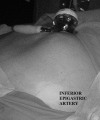Safe introduction of ancillary trocars
- PMID: 23477178
- PMCID: PMC3481235
- DOI: 10.4293/108680812x13427982376464
Safe introduction of ancillary trocars
Abstract
The problem of laparoscopic entry is currently still unsolved, and despite the various techniques adopted by the surgical community, it has not yet been determined which is the correct access in all patients. Add to this the problem of safe ancillary port introduction; all surgeons must avoid vascular and visceral damage. The 2 most common problems with second port trocars are inferior and superior epigastric artery damage, and bowel loops and adhesions. Over the years, we have developed 2 steps that are very useful to avoid iatrogenic injuries to vessels and viscera. In this brief report, we explain the following 2 simple steps, called by the authors "yellow island" port entry and second trocar "tip entry guided" by a suction cannula. In our practice of more than 3400 conventional laparoscopies, with data from patients with different characteristics, surgeons who have introduced laparoscopic surgery into their daily practice might teach these steps to young fellows and trainees.
Figures





Similar articles
-
Safe introduction of ancillary trocars in gynecological surgery: the "yellow island" anatomical landmark.Ann Ital Chir. 2016;87:608-611. Ann Ital Chir. 2016. PMID: 27909270
-
The role of optical access trocars in laparoscopic surgery.Surg Technol Int. 2005;14:61-7. Surg Technol Int. 2005. PMID: 16525956 Review.
-
Laparoscopic entry: a review of techniques, technologies, and complications.J Obstet Gynaecol Can. 2007 May;29(5):433-447. doi: 10.1016/S1701-2163(16)35496-2. J Obstet Gynaecol Can. 2007. PMID: 17493376 Review. English, French.
-
Visualization of the epigastric vessels and bladder before laparoscopic trocar placement.Fertil Steril. 2003 Jul;80(1):209-12. doi: 10.1016/s0015-0282(03)00555-7. Fertil Steril. 2003. PMID: 12849826 Clinical Trial.
-
Trocar injuries in laparoscopic surgery.J Am Coll Surg. 2001 Jun;192(6):677-83. doi: 10.1016/s1072-7515(01)00913-9. J Am Coll Surg. 2001. PMID: 11400960
Cited by
-
Effects of ultrasound guided ganglion stellate blockade on intraoperative and postoperative hemodynamic responses in laparoscopic gynecologic surgery.Wideochir Inne Tech Maloinwazyjne. 2020 Jun;15(2):351-357. doi: 10.5114/wiitm.2019.89653. Epub 2019 Nov 11. Wideochir Inne Tech Maloinwazyjne. 2020. PMID: 32489497 Free PMC article.
-
Surgical management of recurrence of multicompartment pelvic organ prolapse after failure of laparoscopic lateral POP suspension (LLPOPS): initial report of six cases and outcomes at 2 years follow-up.Updates Surg. 2020 Mar;72(1):225-227. doi: 10.1007/s13304-019-00698-1. Epub 2020 Jan 7. Updates Surg. 2020. PMID: 31912441 No abstract available.
-
Trocar-site hernia after gynecological laparoscopic surgery: a 20-year, single-center experience.Chin Med J (Engl). 2019 Nov 20;132(22):2677-2683. doi: 10.1097/CM9.0000000000000510. Chin Med J (Engl). 2019. PMID: 31725450 Free PMC article.
-
Abdominal wall hematoma related to subcutaneous low-molecular-weight heparin injection following coronary intervention therapy: case presentation.J Geriatr Cardiol. 2025 Jan 28;22(1):214-218. doi: 10.26599/1671-5411.2025.01.002. J Geriatr Cardiol. 2025. PMID: 40151627 Free PMC article. No abstract available.
-
Comparison of conventional versus single port laparoscopy for surgical treatment of gynecological diseases: a pilot study.Wideochir Inne Tech Maloinwazyjne. 2022 Mar;17(1):252-260. doi: 10.5114/wiitm.2021.105823. Epub 2021 May 5. Wideochir Inne Tech Maloinwazyjne. 2022. PMID: 35251414 Free PMC article.
References
-
- Deguara C, Davis C. Laparoscopic entry techniques. Curr Opin Obstet Gynecol. 2011;23(4):268–272 - PubMed
-
- Deffieux X, Ballester M, Collinet P, Fauconnier A, Pierre F. Risks associated with laparoscopic entry: guidelines for clinical practice from the French College of Gynaecologists and Obstetricians. Eur J Obstet Gynecol Reprod Biol. 2011;158:159–166 - PubMed
-
- Ahmad G, Duffy JM, Phillips K, Watson A. Laparoscopic entry techniques. Cochrane Database Syst Rev. 2008;(2):CD006583. - PubMed
-
- Tinelli A, Malvasi A, Istre O, Keckstein J, Stark M, Mettler L. Abdominal access in gynaecological laparoscopy: a comparison between direct optical and blind closed access by Veress needle. Eur J Obstet Gynecol Reprod Biol. 2010;148(2):191–194 - PubMed
-
- Tinelli A, Malvasi A, Hudelist G, Istre O, Keckstein J. Abdominal access in gynaecologic laparoscopy: a comparison between direct optical and open access. J Laparoendosc Adv Surg Tech A. 2009;19(4):529–533 - PubMed
MeSH terms
LinkOut - more resources
Full Text Sources
